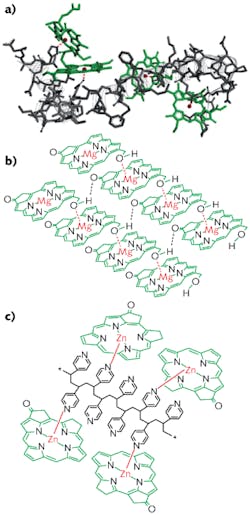Dye-doped polymeric materials have great potential for use in photonic devices such as organic LEDs (OLEDs) and organic photovoltaics. But straightforward approaches to creating these materials have run into some problems, including aggregation of dye molecules, which leads to upper limits to doping levels and optical densities that are too low for use of these materials in thin films. An alternative design approach is biomimetics, or using structures and substances from nature as a design cue.
Researchers from Aalto University and the University of Helsinki, both in Finland, are developing polymeric nanostructures that take advantage of the ultimate natural photonic material: chlorophyll.1 The researchers use chlorophyll that they extract from green plants such as spinach and cyanobacteria, then place them in polymer matrices. The properties of modified chlorophylls can be controlled by altering the pigments’ volume and concentration in these matrices. For example, the interaction between the molecules is dependent on the distance between molecules, which has a great influence on the excitation dynamics.
“If molecules are too close to one another, the absorbed energy is able to spread between them very easily, much in the same way as the waves caused by a drop of water falling into a bucket of water die away in the larger water mass,” says Ilkka Tittonen, a professor at Aalto University’s Department of Micro and Nanosciences.
Chlorophyll naturally accomplishes three things: light absorption, excitation energy transfer, and charge separation. Because the distances between chromophores are important to these processes, these distances should be properly controlled in an artificial environment (such as polymer). In green plants and algae, chlorophyll is held in a protein scaffold in which the molecules have seemingly random orientations; however, in green sulfur bacteria, chlorophyll molecules are formed into planar arrangements via self-assembly (see figure). This arrangement is easier to imitate in the lab, and also leads to strong exitonic coupling between the molecules—which leads to quantum efficiencies close to 100% for energy transfer.
The Aalto University researchers chemically altered natural chlorophyll extracted from algae so that the molecules more easily create large assemblies in solution and solid-state thin films. They used a commercial polymer without further purifying it. The resulting material was then analyzed in the lab via nuclear magnetic resonance, small-angle x-ray scattering (SAXS), brightfield transmission electron microscopy (TEM), and UV-visible and fluorescence spectroscopy (to determine the absorption and fluorescence spectra). The SAXS data indicate a hexagonally packed cylindrical structure for the polymer itself; when the chlorophyll is added, the structure changes, becoming planar and finely layered.
Increasing the proportion of chlorophyll in the polymer produced less fluorescence, showing that the exitonic reactions between the chlorophyll molecules were taking effect. Time-resolved fluorescence measurements showed shorter lifetimes with higher concentrations—and pinpointed the concentration at which the highly efficient exitonic reactions kicked in, which was at between 0.5 and 1.0 wt%.
In this way, the researchers identified how light response alters as molecule density increases in structures in which molecules are bound to polymers with noncovalent bonds. The benefits of this type of solution include low cost, ease of production, and strong sensitivity to light stimulus. Nanophotonics and so-called “functional materials” are possible applications for structures based on chlorophylls. These could be used, for instance, in organic solar cells, LEDs, and lasers.
REFERENCE
1. V. Pale et al., J. Mater. Chem. C, 1, 2166 (2013).

